Mastering Rock Engraving: Essential Tools and Techniques
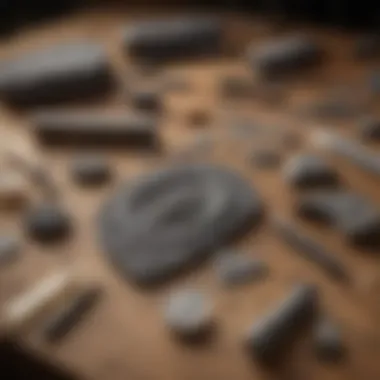
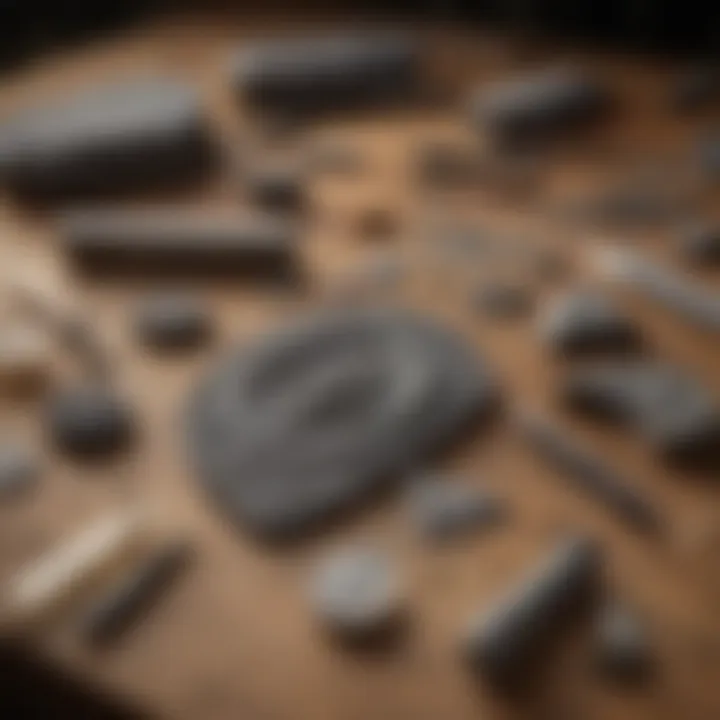
Intro
The art of rock engraving is a practice steeped in history, creativity, and a unique connection to the materials of the earth. While more people are starting to take notice of the aesthetic and cultural importance of this craft, the intricacies behind the techniques and tools used are often overlooked. By understanding the fundamental aspects of engraving rocks, enthusiasts can unlock a realm of creative potential, whether for personal enjoyment or as part of a larger endeavor. This article aims to be a comprehensive guide for anyone interested in delving deeper into the world of rock engraving, merging the practical with the artistic.
History and Origins
Rock engraving’s roots can be traced back thousands of years, forming an essential part of human expression. Early humans wielded simple tools to carve images and shapes into stone, often as a way to document their surroundings or convey messages.
Overview of Collectibles, Rocks, and Fossils
Rocks and fossils are not just simple geological materials; they represent a tangible connection to our planet's history. Collecting rocks can be an enlightening journey, leading one to discover everything from sedimentary layers that tell the tale of ancient oceans to igneous formations born from volcanic activity. Meanwhile, fossils offer a glimpse into the past, capturing the essence of life long gone. Combining these two fields through engraving can create artifacts that serve both aesthetic and educational purposes.
Historical Significance and Cultural Impact
Throughout various cultures, rock engraving has been more than mere decoration. It has had profound significance, often depicting mythological stories, daily life, and spiritual beliefs. In North America, Native American tribes engrave petroglyphs, which tell their unique stories and reflect their relationship with the land. Similarly, the ancient Egyptians used engraving in their tombs to honor the dead, believing that these images would assist them in the afterlife.
Engraving not only reflects cultural expressions but also serves as a record, preserving information that might otherwise fade into obscurity.
Identification and Classification
Understanding the types of rocks and fossils you may encounter is crucial for any rock engraver. Each variety offers unique characteristics that can affect both the engraving technique and the final aesthetic.
Guide to Identifying Rocks and Fossils
Identifying rocks often begins with an inspection of their physical properties: color, hardness, texture, and shape. Familiarizing oneself with common types of rocks—igneous, sedimentary, and metamorphic—can enhance your understanding of the materials at hand. Fossils, on the other hand, are recognized by preserved biological features, such as shell patterns or bone structures.
Common Types and Variations
- Granite: Known for its hardness and speckled appearance, it can lend itself well to detailed designs but requires patience and the right tools.
- Limestone: Softer and more malleable, limestone is often favored for beginners due to its ease of engraving.
- Sandstone: Featuring a range of colors and textures, it provides an interesting surface for creative designs but can be crumbly in nature.
- Fossils: Be it trilobite impressions or plant fossils, incorporating these into rock engraving adds depth and narrative to your project.
"In rock engraving, every stroke tells a story—whether a personal narrative or a shared cultural heritage, the engraved surface speaks volumes."
Armed with this knowledge, budding artists and seasoned collectors alike will find their engagement with rock engraving transformed, providing opportunities for creativity that resonate on both personal and historical levels.
Preamble to Rock Engraving
Engaging in the art of rock engraving opens a fascinating dialogue with nature herself. This form of expression not only transforms a simple stone into a canvas, but also allows an artist to communicate stories, ideas, and emotions through a blend of tools and techniques that date back thousands of years. For both amateur hobbyists and seasoned professionals, understanding the nuances of rock engraving lays the groundwork for crafting visually stunning pieces that resonate with viewers.
Rock engraving offers unique benefits. It provides an avenue for creativity that is somewhat distinct from traditional forms of art. The characteristics of each stone, from its texture to its color, can significantly influence the outcome of a piece. This merges the natural aesthetic of the stone with the engraver's artistic vision. Furthermore, rock engraving can serve practical purposes—creating garden decorations, custom signs, or even simple tokens and gifts, blending utility with art.
Beyond mere aesthetics, this article will delve deeply into the components necessary for successful rock engraving. From the basic understanding of what it entails to exploring historical contexts, every facet serves to enrich your artistic journey. Both newcomers and veterans in the field will benefit from a comprehensive account of the tools and methods employed. Whether you wish to engrave for personal satisfaction or to create meaningful gifts, grasping this art form can transform the way individuals connect with rocks.
Understanding Rock Engraving
Rock engraving is the process of inscribing, carving, or otherwise etching designs onto the surface of stone. Unlike painting or drawing, this technique requires a different kind of precision, often by utilizing specialized tools designed to chip away layers of material. The artistry lies not just in the creation of an image or text, but in how those engravings interact with the inherent properties of the rock itself.
Each rock type presents its own set of challenges and opportunities. Harder stones like granite can produce sharp, clear lines, while softer stones such as limestone may allow for deeper, more textured engravings. The choice of techniques also varies; from linear designs to more intricate patterns involving multiple layers. Engraving techniques can evoke a range of emotions, often reflecting both the artist’s intent and the natural beauty of the rock, making each piece unique.
Historical Context and Significance
From prehistoric times to the modern era, rock engraving has played a significant role in human culture. It is believed that ancient humans engraved symbols and figures onto rocks as a means of communication and record-keeping. This dating back to cave paintings and petroglyphs demonstrates how engravings can bridge generations, providing insight into the beliefs, rituals, and daily lives of early peoples.
In many cultures, rock engravings continue to hold spiritual significance. They can describe events, commemorate important individuals, or serve as markers of territorial claims. Today, the revival of interest in both ancestral techniques and contemporary methods reflects a growing appreciation for this timeless art form.
"Every rock tells a story, and it is the engraver's hand that reveals its voice."
Exploring this historical context reminds us that rock engraving is not just an art; it's a connection to generations past and an opportunity to contribute to an ongoing narrative. As we weave through modern techniques and tools, recognizing the significance of this craft can inspire both respect and creativity, a hallmark of its enduring legacy.
Components of a Rock Engraving Kit
The realm of rock engraving is not just about creativity; it involves a meticulous selection of tools that can make or break your artistic aspirations. This section takes a deeper look into the essential components of a rock engraving kit, shedding light on the fundamental tools every enthusiast should have. When starting this fascinating journey, it’s crucial to know not just what you need but why each tool holds significance in the process.
Basic Tools Required
Engraving Pen Specifications
The engraving pen, an essential tool in any rock engraver's arsenal, serves as the primary instrument for detailed work. An ideal engraving pen typically features a variable speed setting, allowing artists to control the depth and intensity of their strokes. This is paramount as different designs require distinct pressures and speeds to achieve desired effects.
One of the key characteristics of an effective engraving pen is its ergonomic design, which aids in reducing hand fatigue during prolonged sessions. Prolonged use without comfort can lead to imprecise engravings, which is the last thing any artist wants. A notable unique feature of some engraving pens is the exchangeable bits, which can help in switching between fine and coarse finishes seamlessly. However, working with electric engraving tools may require a bit of practice, especially for beginners who might find them tricky compared to traditional hand tools.
Chisels and Hammers
Chisels and hammers might seem rudimentary when placed beside advanced electric tools, yet their role in rock engraving is irreplaceable, particularly for those who appreciate traditional techniques. These tools allow for a tactile connection with the material. While chisels come in various shapes and sizes, a pointed chisel can give you precision needed for detailed lines, while flat chisels work wonders for broader areas.
What sets these tools apart is their simplicity and reliability. A chiseling approach often provides a satisfying, direct feedback from the rock, translating to a deeper appreciation for craftsmanship. The downside? It's more time-consuming compared to modern methods. Enthusiasts sometimes overlook this aspect, but it can also cultivate patience and finesse in one’s work.
Protective Gear
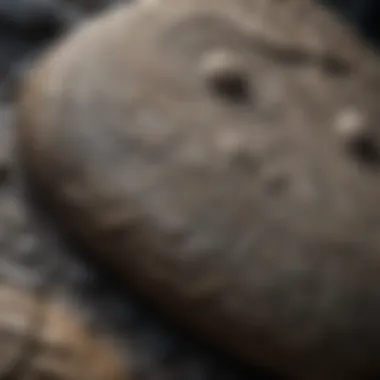
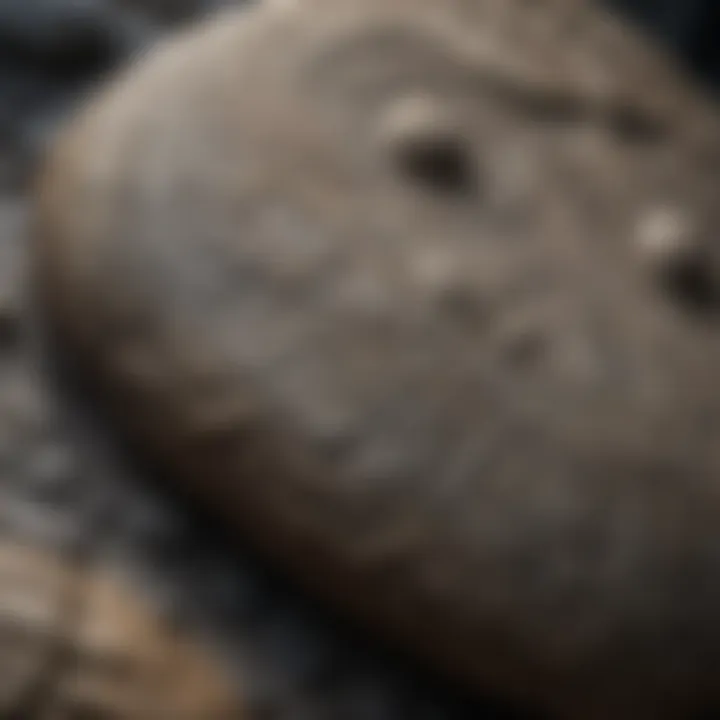
Engaging in rock engraving without proper protective gear is akin to building a house without a roof; you're inviting trouble. Safety goggles, gloves, and dust masks are not optional; they are critical. Working with hard materials produces dust and debris which can be detrimental to your health. For instance, safety goggles will protect against flying chips of rock, whereas gloves offer grip and prevent cuts from sharp tools.
A key characteristic of quality protective gear is their fit and comfort. Gear that fits well encourages consistent use, which is crucial as many forget their safety measures when absorbed in creativity. Some might argue that protective gear feels unwieldy, but it's a small inconvenience compared to the alternative: injuries that could potentially sideline your engraving ambitions.
Advanced Tools for Professional Use
As one's skills advance, the toolkit should evolve as well. For professionals, having access to advanced tools elevates the engraving process significantly. These are no longer mere aids; they become integral companions in the quest for mastery.
Electric Engraving Tools
Electric engraving tools stand at the forefront of modernizing traditional techniques. They are powered, supporting quicker and more intricate designs that might take considerable effort with manual tools. This power allows for various speeds and effects; some models even come with interchangeable tips for diverse textures and patterns, extending your creative horizon.
However, with power comes responsibility; these tools can cause serious injury if mishandled. Proper training and practice can mitigate risks but aligning usage with skill level is paramount. An electric engraving tool can be an artist’s best friend, or it can turn against them if caution isn’t observed.
Templates and Stencils
Templates and stencils play an underappreciated yet crucial role in rock engraving. These tools provide a guiding framework for artists, especially during early stages where precision is vital. They help ensure that designs maintain their integrity through the engraving process. This can be especially beneficial when creating repeat designs, as it allows for consistency across multiple pieces.
One distinct advantage of using these aids is that they spark creativity. By offering patterns to work from, they can inspire artists to expand upon existing designs. The drawback? Relying too heavily on templates can stifle individuality if not balanced prudently.
Specialized Finishing Tools
Lastly, specialized finishing tools are the cherry on top for any serious rock engraver. These tools include various polishing bits and even special sanders designed specifically for achieving that polished finish that makes an engraving pop. These tools can help in refining edges, highlighting details, or simply giving that final touch that distinguishes amateur work from professional art.
Choosing the Right Rock for Engraving
Selecting the right rock for your engraving project is more than just picking a pretty stone. The rock's type, texture, and color can significantly influence both the ease of engraving and the final appearance of the artwork. Different rocks possess unique attributes that can make them better or worse suited for specific engraving techniques. Whether you're a novice looking to experiment or a seasoned engraver aiming for precision, understanding these factors will help ensure your project turns out well.
Types of Rocks and Their Properties
Sedimentary vs. Igneous
When it comes to rock types, sedimentary and igneous rocks each have their traits. Sedimentary rocks, like sandstone or limestone, are layered and composed of particles. They usually offer easy handling for engraving, allowing for intricate designs due to their softer nature. On the flip side, igneous rocks, such as granite, feature a solid structure that can endure weather and time. However, they can be quite challenging to engrave because of their hardness.
For amateur engravers, a sedimentary rock can be a friendlier option as it allows for both detailed work and good results with minimal tools. Yet, professionals may favor igneous rocks for their longevity and durability, perfect for outdoor installations. As a rule of thumb, your choice should be dictated by the desired outcome and the techniques you plan to employ.
Texture Considerations
The texture of a rock plays a vital role too. A smooth surface can make the engraving process significantly easier, as it allows tools to glide effortlessly without snagging. Conversely, a rough texture can present a challenge but may lead to interesting effects when skillfully managed.
For example, a rock with a varied texture can result in a rich tactile experience. It provides depth and complexity to your designs. However, you'll need to be cautious. A more uneven surface might require more time and precision, which could frustrate less experienced engravers.
Color and Design Implications
Color isn’t just about aesthetics; it adds a layer of depth to the meaning and context of your engraved work. Lighter rocks often allow designs to pop out more prominently, making the engraving stand out against the natural hue of the stone. Darker rocks can add a dramatic flair, giving a subtly mystical look if that’s the aim.
The color also impacts how light interacts with the engraving. For example, using dark rocks with a shiny finish might cast reflections that highlight certain aspects of the design. Conversely, a matte finish on a lighter rock might absorb light, providing a more subdued effect. Choosing the right color and finish can elevate your piece from just a carved stone to a true work of art.
Selecting Rock Based on Project Needs
When selecting rock for your project, take a moment to reflect on the end goal. Consider factors like what type of engraving you plan to do, the tools at your disposal, and the setting where the finished piece will reside. For instance, decorative art pieces planned for indoors can allow for more versatility with softer stones, while functional items for outdoor use might call for more durable choices. Knowing your path before you start can save you a world of trouble down the road.
Techniques in Rock Engraving
Understanding the techniques used in rock engraving is essential for anyone looking to master this art form. Techniques not only influence the final outcome but also dictate the effort it takes to achieve intricate designs. Each method serves a unique purpose and can dramatically change how the rock looks once the engraving is complete. Therefore, having a grasp of these techniques will empower both novice and experienced engravers alike. After all, the joy of transforming raw stone into a piece of art cannot be understated.
Basic Engraving Techniques
Linear Engraving
Linear engraving is perhaps the most fundamental technique used in rock engraving. The core characteristic of linear engraving lies in its straight, continuous lines. This method involves the careful manipulation of tools to carve smooth, defined lines into the rock's surface. It's a beneficial choice for those just starting out, as it requires minimal finesse while offering clear results.
The unique feature of linear engraving is its versatility. It works well for creating borders and outlines for more complex designs. However, a disadvantage might be that it can lack depth and dimension if used exclusively. Hence, while it’s simple, it may not stand out without complementing techniques.
Dot Techniques
Dot techniques introduce a different flair to rock engraving. Here, engravers create a pattern of small dots, which can be clustered or spaced out deliberately to form designs. This method is popular due to its ability to produce intricate patterns and textures on the stone.
The key characteristic of dot techniques is that they allow for a greater level of detail, giving depth to the artwork, especially in shading areas. However, it's important to note that this method can be time-consuming, as each dot must be placed with precision.
Surface Texturing
Surface texturing takes things to another level by adding tactile dimensions to rock surfaces. The concept involves altering the texture rather than just creating images or patterns. A roughened surface can provide a unique aesthetic, catching the light differently as it shifts.
This technique stands out because it allows for creativity beyond standard engraving pictures; it wraps the stone in a different style. The downside, however, is that certain textures can be overly aggressive and might compromise the integrity of the rock if not done carefully. Thus, care should be taken to balance aesthetics with structural soundness.
Advanced Techniques for Complex Designs
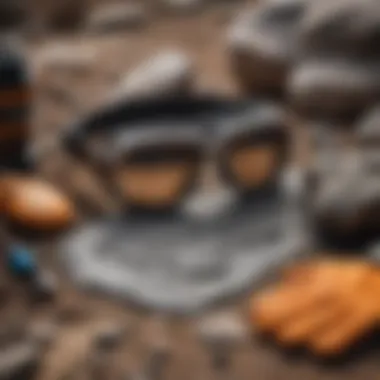
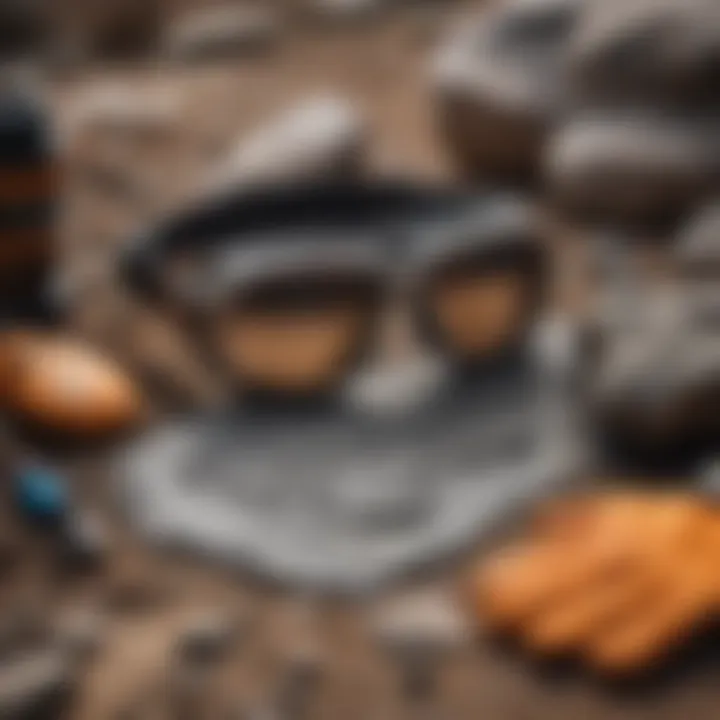
Layered Engraving
Layered engraving brings complexity to the forefront. This method involves the creation of designs where different layers of the rock are revealed through varying depths of the cuts. The primary advantage of layered engraving is that it can produce stunning three-dimensional results, effectively drawing the eye in and inviting closer inspection.
Another remarkable characteristic of layered engraving is its dynamic nature—by playing with depth, one can achieve shadows that add to the overall effect. However, the downside is that mastering this technique requires considerable skill and time, as gauging depth accurately is crucial for successful execution.
3D Effects
If you’ve ever marveled at a rock engraving that seems almost alive, you’ve likely encountered 3D effects. This advanced technique creates the illusion of three dimensions by strategically placing cuts at various depths and angles. It distinguishes itself by adding drama and intrigue to the designs.
These effects are especially advantageous for creating focal points within a piece but require more advanced tools and techniques. A downside is that the learning curve can be steep, requiring practice and patience to execute successfully without ruining the piece.
Combining Techniques
As the name suggests, combining techniques is about innovation. By merging basic and advanced techniques, engravers can create unique designs that stand beyond traditional boundaries. This characteristic of versatility makes the method extremely valuable in the realm of creative endeavors.
One unique feature of combining techniques is that engravers can adjust their approach based on project requirements, allowing for endless possibilities. However, it calls for a deep understanding of each individual technique’s strengths and weaknesses to avoid clashing styles. Therefore, while this approach can yield stunning results, it requires caution when blending different methods together to maintain coherence.
Techniques in rock engraving open the door to creativity and self-expression. By mastering each method, you can elevate your rock art to a new level.
In summary, the diverse techniques discussed here provide the necessary framework for anyone eager to make their mark in rock engraving. Understanding how to wield these methods effectively will pave the way for countless breathtaking projects, adding both depth to your skills and texture to your art.
Safety Considerations in Rock Engraving
Engaging in rock engraving isn't just about creativity and skill; it also involves ensuring personal safety. The very nature of the activity presents certain risks. Without proper precautions, one can easily sustain injuries or face health hazards. Thus, understanding safety considerations is paramount for both beginners and seasoned engravers alike. Not only does it protect the individual, but it enhances the overall experience. Being well-informed and proactive about safety can lead to greater focus on the art itself, as opposed to worrying about potential accidents.
Protective Gear and Its Importance
When venturing into rock engraving, the first line of defense is protective gear. This gear isn't merely an afterthought; it plays a crucial role in safeguarding the engraver from various risks. The most common items include safety goggles, gloves, and dust masks.
- Safety goggles shield the eyes from flying debris that may result from carving or chiseling. One might think, "It won’t happen to me," but the truth is, accidents can strike when least expected.
- Gloves provide a secure grip on tools, reducing the chances of slippage that could cause cuts or other injuries.
- Dust masks are essential because the particles generated during engraving can be harmful to breathe in.
In essence, using protective gear forms a barrier between the artist and potential hazards, greatly minimizing the risk of injury.
Safe Work Practices
Proper Ergonomics
A frequently overlooked yet vital aspect of rock engraving is proper ergonomics. Maintaining the right posture while working can profoundly impact an engraver's long-term health.
- The right chair, an additional cushion, or even adjusting the height of the work surface can make a mountain of difference. Fatigue from awkward positions often leads to unnecessary strain on the back, neck, and wrists.
- Adopting a comfortable wrist position while holding tools also reduces the risk of repetitive strain injuries.
In this article, emphasizing proper ergonomics isn't just a suggestion; it’s a commitment to longevity in the craft. The unique feature here is that investing time in learning about ergonomic practices can enhance efficiency without incurring physical costs.
Handling Tools Safely
Equally important is handling tools safely. Each tool, be it a chisel or an engraver, comes with its own set of protocols. Misuse or carelessness can result in serious harm.
- A key characteristic of safe tool handling involves understanding the function of each tool. Familiarizing oneself with the operations can prevent accidents. For instance, while many may think a sharp chisel is designed only for cutting, improper handling can lead to slips that cause injury or undesirable cuts in the rock.
- Importance should also be given to maintaining tools correctly. Dull tools require more force to operate, increasing the risk of losing control.
Thus, prioritizing safety in handling tools not only protects the user but also enhances the quality of work produced.
Ventilation and Dust Control
Lastly, heading into the realm of ventilation and dust control is critical. Engraving can create a fair amount of dust, and adequate ventilation helps in minimizing health risks associated with inhaling fine particles.
- A well-ventilated workspace allows for the circulation of fresh air, which is beneficial when handling materials that release harmful particles into the air.
- Implementing dust control measures, like using a wet sponge while working or setting up a dedicated workspace outdoors when feasible, effectively reduces the volume of airborne particles.
The unique feature of focusing on ventilation and dust control is how it merges comfort with health, creating a workspace that inspires creativity without compromising well-being.
Maintaining Your Engraving Tools
Maintaining your engraving tools is crucial for ensuring that your rock engraving projects yield the best results. Proper care can enhance the longevity and effectiveness of your tools, saving you time and money in the long run. Well-maintained tools not only function better but also enhance the quality of your engravings. When tools are clean and in good repair, they become an extension of your creative vision, allowing for more precision and ease in your work.
Cleaning and Storage Practices
Keeping your tools clean is the first step in maintaining them. After each use, it is essential to wipe down your engraving pens and chisels to remove any rock dust or debris. Dust accumulation can lead to scratches and unwanted wear. Use a damp cloth for this task, followed by a dry wipe to prevent rust on metal parts.
In terms of storage, make sure your tools are stored in a dry place. A dedicated toolbox or a drawer lined with protective foam can keep tools from knocking against each other and developing nicks and scratches. Additionally, consider labeling your tools so they’re easy to find next time you begin your project. This not only saves time but helps you remain organized in your creative space.
Routine Maintenance and Repairs
Sharpening Tools
Sharpening tools is integral to maintaining their effectiveness. Blunt chisels and engraving pens can result in jagged lines and unclean edges, negatively affecting your artistry. A good tool sharpener for engraving keeps blades fine and ready to carve smoothly.
The key characteristic of sharpening tools lies in their ability to create a keen edge, which is beneficial for any engraver. Regular sharpening helps maintain precision, allowing for intricate designs to be executed flawlessly. Keep in mind, however, that over-sharpening can lead to uneven wear, something to be cautious about.


Identifying Wear and Tear
Recognizing when tools are wearing out is vital for effective maintenance. Identifying wear and tear means paying attention to both the visual and functional aspects of your tools. For example, you might notice that a engraving pen no longer holds a tip snugly, or a chisel feels loose in the grip.
The ability to regularly inspect your tools is beneficial in prolonging their life. Additionally, replacing worn tools sooner rather than later prevents them from negatively impacting your craft. Ignoring these signs can lead to frustration and less-than-satisfactory results in your projects.
Replacing Parts
When maintaining your tools, be prepared to replace parts as necessary. Tools that are frequently used may eventually require new bits, tips, or even complete replacements. Being proactive about this can prevent you from being caught off-guard in the middle of a project.
Packing a replacement part in your toolbox can be a good practice. This allows for swift alterations during work. The unique feature of keeping spare parts handy is that it minimizes downtime, allowing you to maintain a steady flow in your creative process. While it might seem like a trivial matter, it’s those little details that can make or break the overall experience in rock engraving.
Taking the time to maintain your tools can lead to professional results that reflect your artistic abilities.
Engraving is not just about creativity; it’s about the tools you choose and how you care for them. The art of rock engraving flourishes when all components, from technique to tools, are aligned in harmony.
Creative Applications of Rock Engraving
Rock engraving is not merely a craft; it’s a unique way to express personal sentiment and aesthetic flair. The applications of this art are varied and fascinating. Every piece tells a story, whether it’s for decoration, functionality, or a heartfelt gift. Understanding these creative outlets can enhance one’s appreciation for rock engraving, turning an ordinary stone into something meaningful. From personalized keepsakes to practical signage, the versatility of this art form offers endless possibilities for creators and gift-givers alike.
Personalized Gifts and Keepsakes
Engraving rocks to create personalized gifts stands out as one of the most heartfelt applications of this craft. Imagine gifting someone a perfectly etched stone with their name or a significant date—it's not just a gift, it's a memory captured in stone. This practice allows for thoughtful customization that can resonate with both the giver and receiver.
Engraved stones can commemorate special occasions such as anniversaries, graduations, or even the birth of a child. When tailored with names or personal messages, these gifts turn ordinary stones into cherished keepsakes. Furthermore, the tactile quality of rock adds an element of warmth that printed materials lack, making this option truly unique.
Decorative Art and Home Accents
When it comes to beautifying living spaces, rock engraving offers a refined touch that’s hard to match. Whether displayed on a mantle, in a garden, or even hanging on a wall, engraved rocks can serve as art pieces that enhance one’s decor. The range of designs can vary from elegant patterns to nature-inspired motifs.
Such pieces can become conversation starters, as they combine nature’s raw beauty with artistic expression. The integration of engraved stones in decor can evoke a sense of sophistication. The uniqueness of each rock ensures that every piece is one-of-a-kind, allowing homeowners to showcase their individual style.
Functional Items and Signage
When functionality meets artistry, you have the world of functional rock engraving. This category includes items that not only serve a purpose but also infuse personality into everyday objects.
Garden Decorations
Garden decorations crafted from engraved stones are particularly popular. They add a rustic charm to outdoor spaces. Flower beds, pathways, or seating areas can be marked with engraved stones, providing guidance or showcasing favorite quotes.
One key characteristic of garden stones is their durability; they can withstand harsh weather while still looking beautiful. Their unique designs appeal to gardeners and landscape lovers, transforming an ordinary patch of land into a remarkable visual experience.
However, it’s essential to consider the placement and design carefully, as some stones may wear faster when exposed to the elements. To keep their beauty intact, regular maintenance might be needed, like cleaning and sealing the stones.
Custom House Signs
Now, let’s talk about custom house signs. These engraved markers help identify residences uniquely, presenting not only a name but also a sense of personality and pride in homeownership. Each sign serves as a welcome mat that adds character to the entrance of a home.
One striking feature of custom house signs is their ability to combine function with flair. They can be quite striking when crafted from materials like granite, which ensure longevity while remaining visually appealing. Additionally, they can be personalized according to the owner’s preferences, making them a sought-after choice.
One downside might be the cost involved in creating these personalized signs, particularly if intricate designs are required. However, the initial investment often pays off in terms of aesthetics and unique identifiers for the home.
Engraving rocks merges art with sentiment, creating personalized touches that resonate deeply while also being functional.
In summary, the creative applications of rock engraving are as diverse as the experiences each individual brings to the table. Whether you’re seeking a personal gift, an accent piece for your home, or a functional sign, the possibilities are boundless. Engraving rocks transforms stones into vessels of creativity, memory, and identity.
Community and Resources
When more and more people are taking an interest in rock engraving, it’s vital to tap into a community that shares similar passions. Not only can it provide camaraderie, but also a wealth of knowledge that can elevate one’s skill level. Collaborating with other artists can unveil new techniques, tools, and inspirations that might not have been considered before. Connecting with a local or online community can also open doors to workshops, exhibitions, and group projects that enhance both learning and creativity.
Finding a Local Engraving Community
Seeking out local engraving groups can catapult your practice onto another level. A vibrant local community can offer hands-on experience which is simply invaluable. Engaging face to face can lead to immediate feedback and support that online platforms might not fully replicate. Whether it’s a group of enthusiasts meeting weekly or a specialized art class at the community center, these settings can be ripe for not only honing specific skills but also building lasting friendships.
In some regions, art co-ops or galleries host events spotlighting local artisans. Joining such events can help you meet others who share similar interests and experiences. Moreover, if you’re lucky enough to live in an area with a rich artistic tradition, you might find mentors willing to share their crafts and tips.
Online Resources and Courses
The digital age has radicalized the way we learn and engage with art forms. Online resources are abundant and can cater to anyone from beginners to experienced painters. Let’s break down the treasures in this space.
Websites and Forums
Websites and forums create a platform for sharing knowledge and experiences freely. Forums such as Reddit often have dedicated threads where users post their projects, seek advice, or share tips. The community here is generally eager to help and answer questions, making it a supportive environment for learning. The key characteristic of such platforms is their interactivity—users can freely engage, react, and contribute.
One of the unique features of these communities is the variety of opinions and styles presented. You're likely to encounter various perspectives on techniques or materials that you might not have considered previously. However, one disadvantage is that, sometimes, information can be inconsistent, so it's wise to verify claims with external resources.
Video Tutorials and Workshops
Video tutorials and online workshops bring an additional layer of learning, tapping into visual and auditory senses. Platforms like YouTube are teeming with detailed guides on various engraving techniques. These tutorials allow you to learn at your own pace, rewind, and practice alongside the video. Their key characteristic lies in their visual demonstrations, which often lead to a more comprehensible and engaging experience than written text alone.
One main advantage is the ability to watch experienced artisans demonstrate tools and techniques in real-time. You receive instant gratification and can see results quickly through hands-on practice. Nonetheless, a potential drawback is the time required to sift through videos to find those that resonate with your level of skill or interests, which can sometimes feel like looking for a needle in a haystack.
"In art, as in life, it is vital to connect with others who share your passion. The right community can transform your journey from solitary to extraordinary."
Harnessing the power of community and available resources can greatly amplify your experience in rock engraving. It’s not merely about the end product but the shared journey, allowing you to grow and indulge your creative spirit in ways you never imagined.



